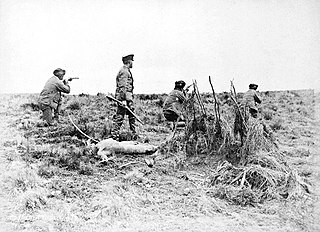
Tierra del Fuego is an archipelago off the southernmost tip of the South American mainland, across the Strait of Magellan.

Penicillium is a genus of ascomycetous fungi that is part of the mycobiome of many species and is of major importance in the natural environment, in food spoilage, and in food and drug production.

Isla Grande de Tierra del Fuego also formerly Isla de Xátiva is an island near the southern tip of South America from which it is separated by the Strait of Magellan. The western portion (61.4%) of the island is in Chile, while the eastern portion is in Argentina. It forms the major landmass in an extended group of islands or archipelago also known as Tierra del Fuego.

Tierra del Fuego National Park is a national park on the Argentine part of the island of Tierra del Fuego, within Tierra del Fuego Province in the ecoregion of Patagonic Forest and Altos Andes, a part of the subantarctic forest. Established on 15 October 1960 under the Law 15.554 and expanded in 1966, it was the first shoreline national park to be established in Argentina.

The Selk'nam genocide refers to the systematic extermination of the Selk'nam or Ona people, one of three indigenous tribes populating Tierra del Fuego in South America, from the second half of the 19th to the early 20th century. The genocide spanned a period of between ten and fifteen years. The Selk'nam had an estimated population of 4,000 people around the 1880s but saw their numbers reduced to 500 by the early 1900s.

The Sociedad Explotadora de Tierra del Fuego was a historically important company operating within the Chilean and Argentine region of Patagonia. It was founded in 1893 and cultivated over 1,000,000 ha land for sheep farming and private factories like Puerto Bories to process, freeze and export sheep meat.
Penicillium alicantinum is a fungus species of the genus of Penicillium which was isolated from the atmosphere in Madrid.
Penicillium corynephorum is an anamorph species of the genus of Penicillium.
Penicillium inusitatum is a species of the genus of Penicillium.
Penicillium lacus-sarmientei is an anamorph species of the genus of Penicillium which was isolated from soil of the shores of the Lake Sarmiento in the Chilean Tierra del Fuego.
Penicillium lapidosum is an anamorph species of the genus of Penicillium which produces patulin.
Penicillium lineatum is a species of the genus of Penicillium.
Penicillium malacaense is an anamorph species of the genus of Penicillium.
Penicillium murcianum is an anamorph species of the genus Penicillium.
Penicillium onobense is an anamorph species in the genus Penicillium which was isolated from beech forest in Navarra in Spain.
Penicillium palitans is an anamorph species of fungus in the genus Penicillium which was isolated from cheese and ancient permafrost deposits. Penicillium palitans produces viridicatin, cyclopiazonic acid, roquefortine, palitantin and ochratoxin A
Penicillium rubefaciens is a species of fungus in the genus Penicillium which has been isolated from sandy soil.
Penicillium sacculum is an anamorph species of fungus in the genus Penicillium which produces the xanthone 1-hydroxy-3-methoxy-6-sulfo-8-methylxanthone. Penicillium sacculum was isolated from the halophyte plant Atriplex
Penicillium striatisporum is an anamorph species of fungus in the genus Penicillium which was isolated from the rhizosphere of chilli peppers. Penicillium striatisporum has a selective antifungal activity against Candida albicans This species produces striatisporin A, striatisporolide A, versiol, calbistrin C, deformylcalbistrin A, citromycetin, citromycin, fulvic acid, (-)-2,3-dihydrocitromycetin and (+)-hexylitaconic acid
Penicillium vasconiae is a species of fungus in the genus Penicillium which was isolated in Madrid in Spain.





